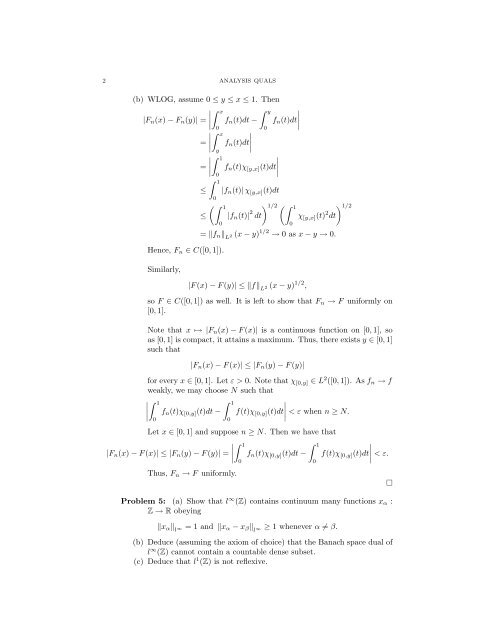ANALYSIS QUALIFYING EXAM PROBLEMS BRIAN LEARY ...
ANALYSIS QUALIFYING EXAM PROBLEMS BRIAN LEARY ...
ANALYSIS QUALIFYING EXAM PROBLEMS BRIAN LEARY ...
Create successful ePaper yourself
Turn your PDF publications into a flip-book with our unique Google optimized e-Paper software.
2 <strong>ANALYSIS</strong> QUALS<br />
(b) WLOG, assume 0 ≤ y ≤ x ≤ 1. Then<br />
<br />
x y <br />
<br />
|Fn(x) − Fn(y)| = <br />
fn(t)dt − fn(t)dt<br />
<br />
0<br />
0<br />
<br />
x <br />
<br />
= <br />
fn(t)dt<br />
<br />
y<br />
<br />
1<br />
<br />
<br />
= <br />
fn(t)χ [y,x](t)dt<br />
<br />
≤<br />
≤<br />
0<br />
1<br />
0<br />
1<br />
Hence, Fn ∈ C([0, 1]).<br />
Similarly,<br />
0<br />
|fn(t)| χ [y,x](t)dt<br />
|fn(t)| 2 dt<br />
1/2 1<br />
χ [y,x](t)<br />
0<br />
2 1/2<br />
dt<br />
= fn L 2 (x − y) 1/2 → 0 as x − y → 0.<br />
|F (x) − F (y)| ≤ f L 2 (x − y) 1/2 ,<br />
so F ∈ C([0, 1]) as well. It is left to show that Fn → F uniformly on<br />
[0, 1].<br />
Note that x ↦→ |Fn(x) − F (x)| is a continuous function on [0, 1], so<br />
as [0, 1] is compact, it attains a maximum. Thus, there exists y ∈ [0, 1]<br />
such that<br />
|Fn(x) − F (x)| ≤ |Fn(y) − F (y)|<br />
for every x ∈ [0, 1]. Let ε > 0. Note that χ [0,y] ∈ L 2 ([0, 1]). As fn → f<br />
weakly, we may choose N such that<br />
<br />
1<br />
1<br />
<br />
<br />
<br />
fn(t)χ [0,y](t)dt − f(t)χ [0,y](t)dt<br />
< ε when n ≥ N.<br />
0<br />
0<br />
Let x ∈ [0, 1] and suppose n ≥ N. Then we have that<br />
<br />
1<br />
1<br />
<br />
<br />
|Fn(x) − F (x)| ≤ |Fn(y) − F (y)| = <br />
fn(t)χ [0,y](t)dt − f(t)χ [0,y](t)dt<br />
< ε.<br />
Thus, Fn → F uniformly.<br />
0<br />
Problem 5: (a) Show that l ∞ (Z) contains continuum many functions xα :<br />
Z → R obeying<br />
xα l ∞ = 1 and xα − xβ l ∞ ≥ 1 whenever α = β.<br />
(b) Deduce (assuming the axiom of choice) that the Banach space dual of<br />
l ∞ (Z) cannot contain a countable dense subset.<br />
(c) Deduce that l 1 (Z) is not reflexive.<br />
0
















